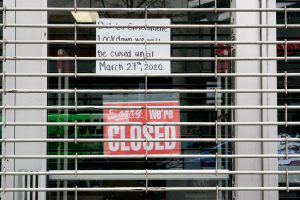By Emily Previti | PA Post

Unemployment claims have reached historic levels nationwide as coronavirus mitigation efforts effectively shutter the national economy, and it’s Pennsylvania that is outpacing the nation in the number of claims filed.
The Commonwealth’s unemployment compensation program saw more than 378,900 claims filed during the week ending March 21. That’s 6 percent of the workforce in the nation’s sixth-most-populous state, a higher percentage of unemployed workers than any in any other state except Nevada and Rhode Island, according to our analysis of the latest nationwide numbers available from the U.S. Department of Labor.
The deluge of claims continued with another half million submitted last week. So many Pennsylvanians attempted to file on Monday of this week that the state’s computer system was overwhelmed multiple times.
So, the question is: Why is the crush of unemployment claims so great in Pennsylvania?
Chris O’Leary, a senior economist at the Upjohn Institute in Michigan, said one reason is the state’s early steps to halt or slow the coronavirus outbreak. Pennsylvania leaders were stressing “social distancing” measures well ahead of many other states, he said, which could have slowed the economy and led more businesses to lay off workers sooner than in other states.
Pennsylvania Labor Secretary Jerry Oleksiak made a similar point when asked earlier this week. He pegged the state’s volume of claims to Gov. Tom Wolf’s relatively quick moves to close non-essential businesses.
“The governor was, early on, mitigating as much as he possibly could,” Oleksiak said. “It started with Montgomery County, where I live. … Then quickly, that spread throughout the Commonwealth, those closures and people working from home.”
Ahead of his March 19 executive order shutting down all non-essential businesses statewide, Wolf was encouraging employers to close. And on March 17 he announced that Pennsylvania workers could file for unemployment benefits immediately rather than comply with the one-week waiting period.
But waiving the waiting period isn’t unique to Pennsylvania and can’t, by itself, explain the big number of claims filed in the Commonwealth. The majority of states announced their own “waiting week” waivers the same day or had done so during the week prior (some typically allow immediate filing, anyway). All but a handful of states have since followed suit.
Another factor, Oleksiak noted, is that Pennsylvania doesn’t require employers to provide paid sick or medical leave.
“For many of our citizens, we are the first place [they] can turn to when they face unemployment issues,” he said.
That’s true in most states, though, so this factor alone doesn’t explain Pennsylvania’s surge in claims. Only a dozen states mandate paid leave – including Nevada, where nearly 7 percent of its workforce filed for unemployment, and Massachusetts, where 4 percent did so (and some states exempt smaller companies, according to the National Conference of State Legislatures).
The speed and high rate of filing here also could result from union presence in the state, experts say.
About 13 percent of Pennsylvania workers are in a union or represented by an employee association, more than in 35 other states, according to Bureau of Labor Statistics data from 2019 (the most recent available).
That’s probably driving the high number of claims, at least in part, given non-union workers are far more likely to file for unemployment, said Julia Simon, supervising attorney in the unemployment compensation unit at Philadelphia Legal Assistance.
“Pennsylvania also … has one of the best benefits packages in the country,” Simon said. “And workers are aware of that.”
The maximum payout under Pennsylvania’s unemployment program last year was $569, more than 36 other states, according to this comparison.
Pennsylvania workers also pay into the unemployment system directly and can see it on their pay statements – one of just three states (New Jersey and Alaska are the others) where that is the case, experts said.
“In my experience representing people, they certainly feel a sense of investment,” Simon said.
To O’Leary of the Upjohn Institute, that sense of ownership affects public attitudes toward utilizing unemployment benefits, making it less likely Pennsylvanians will hesitate to file.
“People know it’s something they’ve paid into,” O’Leary said. “Seeing you pay for the insurance gives you a proper sense that you have earned this. That it’s not welfare, that it’s insurance against the risk of unemployment, it’s an earned entitlement.”
Simon of Philadelphia Legal Assistance said workers also benefited, in this case, from coordinated statewide efforts among public officials, unions, community groups, advocates and employers to get the word out about what’s available for people who’ve been laid off.
“We’ve been pushing out materials and info to folks on webinars, posts, list serves, Facebook,” Simon said. “We have really tried to make sure people have the information they need and understand there’s no need to wait.”
Overall, the unemployment filing crush in Pennsylvania reflects what’s already happening nationally and likely foreshadows what’s to come elsewhere, as this Wall Street Journal story explored.

PA Post is a digital-first, citizen-focused news organization that connects Pennsylvanians with accountability and deep-dive reporting.








